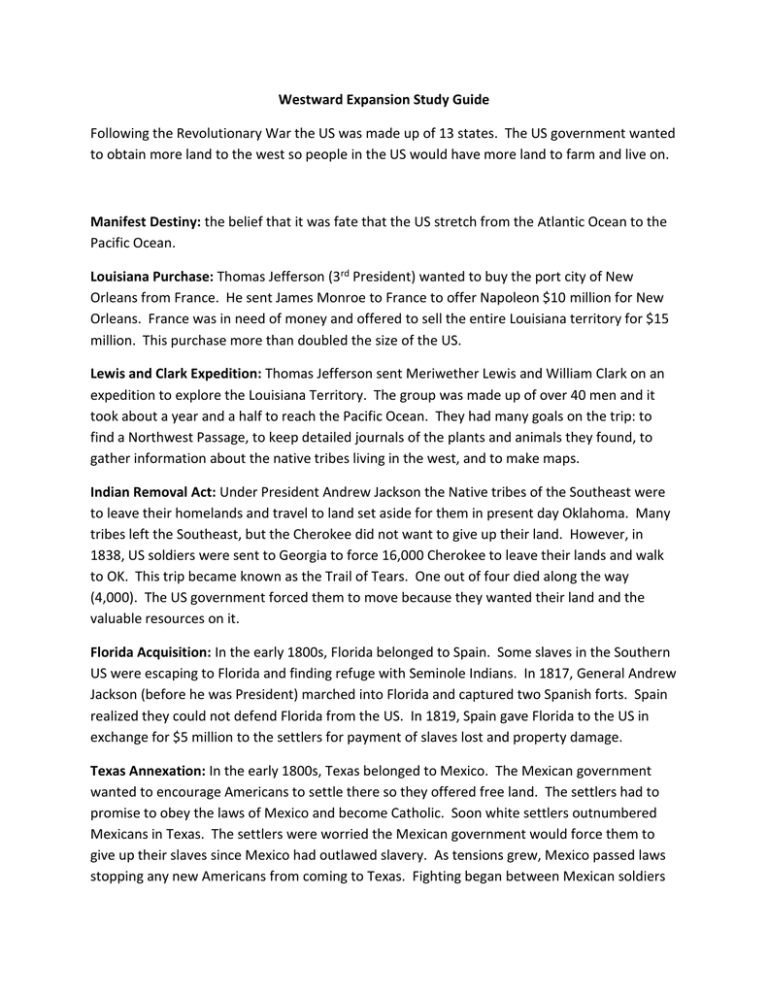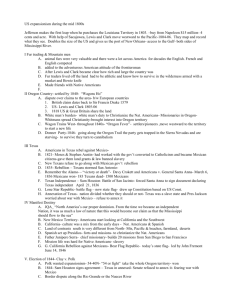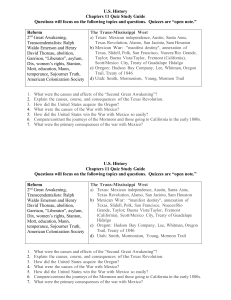Westward Expansion Study Guide
advertisement

Westward Expansion Study Guide Following the Revolutionary War the US was made up of 13 states. The US government wanted to obtain more land to the west so people in the US would have more land to farm and live on. Manifest Destiny: the belief that it was fate that the US stretch from the Atlantic Ocean to the Pacific Ocean. Louisiana Purchase: Thomas Jefferson (3rd President) wanted to buy the port city of New Orleans from France. He sent James Monroe to France to offer Napoleon $10 million for New Orleans. France was in need of money and offered to sell the entire Louisiana territory for $15 million. This purchase more than doubled the size of the US. Lewis and Clark Expedition: Thomas Jefferson sent Meriwether Lewis and William Clark on an expedition to explore the Louisiana Territory. The group was made up of over 40 men and it took about a year and a half to reach the Pacific Ocean. They had many goals on the trip: to find a Northwest Passage, to keep detailed journals of the plants and animals they found, to gather information about the native tribes living in the west, and to make maps. Indian Removal Act: Under President Andrew Jackson the Native tribes of the Southeast were to leave their homelands and travel to land set aside for them in present day Oklahoma. Many tribes left the Southeast, but the Cherokee did not want to give up their land. However, in 1838, US soldiers were sent to Georgia to force 16,000 Cherokee to leave their lands and walk to OK. This trip became known as the Trail of Tears. One out of four died along the way (4,000). The US government forced them to move because they wanted their land and the valuable resources on it. Florida Acquisition: In the early 1800s, Florida belonged to Spain. Some slaves in the Southern US were escaping to Florida and finding refuge with Seminole Indians. In 1817, General Andrew Jackson (before he was President) marched into Florida and captured two Spanish forts. Spain realized they could not defend Florida from the US. In 1819, Spain gave Florida to the US in exchange for $5 million to the settlers for payment of slaves lost and property damage. Texas Annexation: In the early 1800s, Texas belonged to Mexico. The Mexican government wanted to encourage Americans to settle there so they offered free land. The settlers had to promise to obey the laws of Mexico and become Catholic. Soon white settlers outnumbered Mexicans in Texas. The settlers were worried the Mexican government would force them to give up their slaves since Mexico had outlawed slavery. As tensions grew, Mexico passed laws stopping any new Americans from coming to Texas. Fighting began between Mexican soldiers and American settlers. Texas wanted to be an independent nation. At the battle of the Alamo, Mexican soldiers killed every man in the fort. Angered, Texans formed their own government and later attacked the Mexican soldiers capturing their leader, Santa Anna. He was let go when he promised Texas independence. For nine years Texas was its own nation. In 1845, Texas became the 28th US state. Acquisition of Oregon Country (present day Oregon and Washington): In the early 1800s, this land was occupied by both British and American citizens. To avoid more fighting, Great Britain and the United States agreed on a boundary line to divide the land. Mexican Cession and Gadsden Purchase: The US and Mexico fought in the Mexican War when Mexico wanted Texas back. The US eventually won the war and Mexico gave the US land in present day California, New Mexico, Utah and Nevada. Later the US purchased land in present day Arizona and New Mexico from Mexico for $10 million. People Who Helped Settle the West Mexicanos: These were Mexican ranchers, or cowboys. They adapted to the harsh conditions of the West by building adobe houses and using irrigation for crops. Forty-niners: These men rushed to California when gold was discovered there in 1849. They hoped to strike it rich. Very few made any money from their claim, land worked by the miner. Chinese Immigrants: Many Chinese came to America to work in the gold mines. Many then found work on the Transcontinental Railroad. These workers often earned less money than American workers and had to work longer hours and do riskier work. Mormons: This group headed west seeking religious freedom. They eventually settled in the Great Salt Lake region of Utah. Oregon Pioneers: People heard tales of good farmland and rich forests in Oregon Country. Many decided to head west in wagon trains. The people traveled in large groups and worked together to make the journey. The trip was very difficult, but the chance of a better life was worth the risk for many. Nez Perces: This tribe lived in lands of present day Oregon, Idaho, and Washington. As more white settlers entered the area, they wanted the land. The Nez Perces were being forced onto reservations. One chief, Chief Joseph, feared his people would be attacked by US soldiers. He led a group to try and escape to Canada. They were eventually captured and many were killed. They were taken to reservations in present day OK.





